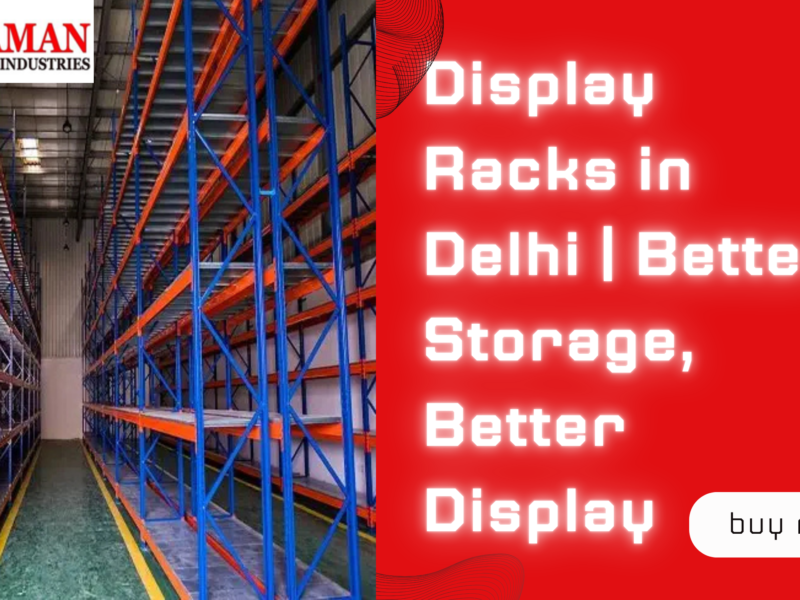The retail business is already in the process of the metamorphosis due to introduction of technologies that what is a new way of shopping and or product presentation. Further, display racks are no longer basic wooden or metal structures; they’re evolving into complex tools and interfaces melded into technology to improve the shopping experience. To that end, in this article, we will look at how display technology is revolutionizing the display rack and the implications for the retail market.
Retal Technology Transformed
A comprehensive insight into the nature of retail transformation owing to the advancement of technologies is briefly described as follows.
Retail has evolved a lot from the standard shop case scenario of a physical store. Over the course of several years, due to the improving popularity of e-commerce retailers felt pressure because of such changes. From end-to-end customized shopping solutions to better demand fulfillment and forecasting, technology has emerged as the next big thing in the retail business.
Display racks, also known as fixtures, remain one of the most important tools in a modern retail strategy.
Display racks are no longer just static fixtures. They play a pivotal role in attracting customers, organizing products, and even facilitating transactions. As technology continues to advance, display racks are becoming more interactive and efficient, transforming how products are presented and sold.
Technologies That have Transform Display Racks
- Smart Display Racks
Smart display racks use sensors and touch screens on the shelves to give merchants details on product sales. Products stored in these racks can inform inventory status, observe customers’ behaviour, and even change the price depending on customer traffic.
Data-Driven Decisions: Smart racks can enable the supermarket retailers to take proper strategic decisions on product placement based on stocks management to achieve a proper stocking of popular items.
- integration of Augmented Reality (AR)
The use of augmented reality is transforming how customers engage with the products they are interested in. AR assists clients with seeing how certain effects or products would sit in their home or even on their body making shopping easier.
Interactive Displays: Self-checkout kiosks refer to display racks that use augmented reality to make customers use their smartphone to scan an item and be provided with, for instance, reviews or how to wear it.
- Digital Signage
Digital signage is appearing more frequently in locations within and around the store for eye-popping product displays and sales pitches. Fixed separate shelves with practical electronic boards can also be used to advertise a product, present a video commercial or share positive feedback.
Engaging Content: It garners the attention of customers and can easily be changed to reflect sales, discounts, arrivals and all sorts of things making the store looking new all the time.
- RFID Technology
RFID technology is beginning to drastically change the way that inventory is managed. Mobile shelving with RFID tags used can be mounted on the display racks so that products can be traced across the store, and assuming that the problem of theft was controlled stocks would be accurate.
Streamlined Inventory: Large stores and supermarkets can have their stores restocked and inventories taken by automatic means thereby ensuring that the store has the right products for the customer at the right time.
- One of these benefits is that designs have to be both customizable and modular.
Technology is also affecting the design of the display racks themselves. There are currently manufactured sections of retail shelves or racks which can be moved around or modified to suit changes that may be made on certain lines of merchandize or seasonal variations.
BENEFITS ASSOCIATED TO THE USE OF TECHNOLOGY DISPLAY RACKS
- Enhanced Customer Experience
Display racks feature technology, giving the shopping experience a more colorful and eliciting feel. The enterprise is able to provide customers tailored service and products, thereby enhancing their satisfaction and believability.
Informed Decisions: Smart racks and AR provide consumers with extra information about products and customers’ experience that ultimately leads to informed decisions.
- Higher Stocks and Conversion Profit Margins
The use of technological display racks hastens the possibilities of converting the customers because the shelves grab their attention as well as encourage them to buy on impulse.
Strategic Promotions: Digital Signage can be used by the retailers to display any sale on items that are usually Chess for time or stock items occasionally, which gives the customer a perception that such products or services are in high demand and may run out of stock at any one time.
- Reduced Operation Costs
RFID integrated with smart shelves assists retailers in managing their stores better, cutting inefficiencies, and guaranteeing adequate stock of the most-sold products.
Time Savings: These adjustments enable staffs to direct their attention on customer service rather than tiring task of doing physical stock takes and stocks control.
- Data-Driven Insights
The solution components of smart display racks can provide valuable information to retailers regarding consumer behavior and needs, so that retailers can offer what will benefit consumers the most.
Trend Analysis: Know which products are preferred will help in future purchase requirements and even in advertising and promotions.
The Future of Retail Displays: Trends to Watch
1. Sustainability Focus
As consumers become more environmentally conscious, the demand for sustainable retail practices will influence display rack design. Eco-friendly materials and designs that minimize waste will be increasingly sought after.
- Sustainable Solutions: Retailers will need to invest in racks that align with their sustainability goals while still being functional and appealing.
2. Omnichannel Integration
The lines between online and offline shopping are blurring. Display racks will need to support omnichannel strategies, allowing for seamless integration of in-store and online experiences.
- Click-and-Collect Solutions: Racks that facilitate easy access to items for in-store pickup or allow for online orders to be fulfilled from the store will become more common.
3. Personalization and Customization
As data analytics advance, retailers will be able to offer more personalized shopping experiences through display racks that adapt to individual customer preferences.
- Tailored Offerings: Display racks could showcase products based on a customer’s shopping history or preferences, enhancing the likelihood of conversion.
Conclusion: Embracing the Future of Retail
The transformation of display racks through technology is not just a trend but a significant shift in how retailers operate. By embracing these innovations, retailers can create more engaging and efficient shopping experiences that cater to the evolving needs of consumers. The future of retail is bright, and with the right technological investments, display racks will continue to play a vital role in driving sales and enhancing customer satisfaction.
FAQs
- What are smart display racks?
Smart display racks are equipped with sensors and digital displays that provide real-time data on product performance, helping retailers manage inventory more effectively. - How does augmented reality enhance shopping experiences?
AR allows customers to visualize products in their own environments or see additional product information through their smartphones, creating an interactive shopping experience. - What advantages does RFID technology provide in retail?
RFID technology improves inventory management by allowing retailers to track products accurately and automate stock counts, reducing theft and ensuring availability. - How can digital signage impact sales?
Digital signage can dynamically showcase promotions, product videos, and customer testimonials, capturing attention and encouraging impulse buys. - What are the future trends for display racks in retail?
Future trends include a focus on sustainability, omnichannel integration, and increased personalization to meet the demands of modern consumers.


